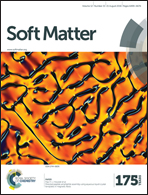Formation of semi-dilute adhesion domains driven by weak elasticity-mediated interactions
Abstract
Cell–cell adhesion is established by specific binding of receptor and ligand proteins anchored in the cell membranes. The adhesion bonds attract each other and often aggregate into large clusters that are central to many biological processes. One possible origin of attractive interactions between adhesion bonds is the elastic response of the membranes to their deformation by the bonds. Here, we analyze these elasticity-mediated interactions using a novel mean-field approach. Our analysis of systems at different densities of bonds, ϕ, reveals that the phase diagram, i.e., the binodal and spinodal lines, exhibit a nearly universal behavior when the temperature T is plotted against the scaled density x = ϕξ2, where ξ is the linear size of the membrane's region affected by the presence of a single isolated bond. The critical point (ϕc , Tc) is located at very low densities, and slightly below Tc we identify phase coexistence between two low-density phases. Dense adhesion domains are observed only when the height by which the bonds deform the membranes, h0, is much larger than their thermal roughness, Δ, which occurs at very low temperatures T ≪ Tc. We, thus, conclude that the elasticity-mediated interactions are weak and cannot be regarded as responsible for the formation of dense adhesion domains. The weakness of the elasticity-mediated effect and its relevance to dilute systems only can be attributed to the fact that the membrane's elastic energy saturates in the semi-dilute regime, when the typical spacing between the bonds r ≳ ξ, i.e., for x ≲ 1. Therefore, at higher densities, only the mixing entropy of the bonds (which always favors uniform distributions) is thermodynamically relevant. We discuss the implications of our results for the question of immunological synapse formation, and demonstrate that the elasticity-mediated interactions may be involved in the aggregation of these semi-dilute membrane domains.


 Please wait while we load your content...
Please wait while we load your content...